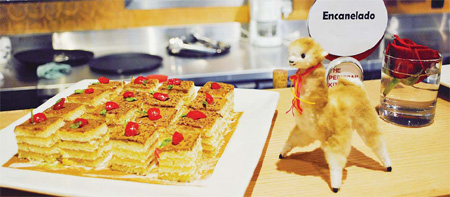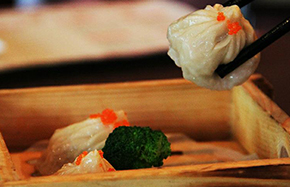Discover 'The Lost Cuisine' of Peru
|
Rich desserts (left) are one highlight of Peruvian food; cuddly vicunas (right) are not. Provided to China Daily |
Time to take a bite out of the best national dishes never to have gone global, Matt Hodges reports.
Machu Picchu, the ancient citadel dubbed "The Lost City of the Incas'", has become Peru's top tourist attraction despite being hidden by the jungle for centuries.
The country's cuisine has no such excuse for its global obscurity, however, and should be called "The World's Great Undiscovered Supper (or Lunch)". All it needs is a culinary Christopher Columbus like Jaime Oliver, or Delia Smith, to put it on the map.
Forget Lake Titicaca or the animal-shaped Nazca Lines, Peruvian dishes and their use of seafood, spices and chilies provide ample reason to visit the country, as a trip to the Peruvian Kitchen by Eduardo Vargas inside the Peru Pavilion soon reveals.
Peru has a few claims to fame, such as introducing potatoes to the rest of the world and filling its people's palates with some of the best desserts imaginable. It also claims to have brought ceviche - that much-loved Latin American dish of raw fish marinated in citrus juices and flavored with spices - over from Spain. Then again, so do about a dozen other countries south of the US-Mexican border.
However it is pisco that stands out as perhaps the world's easiest national liquor on which to get unwittingly sloshed. The restaurant's 35-yuan cocktail version, the Pisco Sour, masks its high alcohol content (40-45 percent proof) with limejuice, sugar-syrup and egg white. It goes down like Powerade laced with tequila.
Head Chef Maria Rose Vasquez has done a superb job of representing the country's three geographic regions of coastland, highland and jungle on the menu. Instead of trying to highlight all of its 25 regions and the territory of Lima, she has drawn broader strokes, dividing the dishes into those belonging to the north, center and south of the country.
The only regrettable omission is that of the Amazon jungle fish, such as paiche - if only because the location makes them sound so darned cool.
The restaurant aims to reflect the different combinations of the five main chilies that flavor Peruvian dishes, of which Vasquez claims there are 3,000 (other sources put the number of dishes much lower, at 500). Many of these do however show the influence of Arequipa, the southern border town in which Vasquez was born.
The first thing you need to know is that Peruvian chefs are nuts about chilies. When Vasquez starts talking about them, her eyes light up, especially if the pepper in question happens to be yellow.
We ordered a range of dishes based on the chef's recommendations. These began with the Peruvian Chili Chicken (90 yuan), Braised Lamb Shank (120 yuan) - funnily enough, both are made using yellow chilies - Fish Ceviche (90 yuan), Peruvian Seafood Rice (100 yuan) and Peruvian-style Beef Stir-Fried (120 yuan).
The beef, which is flavored with soy sauce and flame-grilled with pisco to give it a crispy edge, pays testament to the strong influence of Chinese immigrant laborers, who arrived in Peru in the 1850s. Vasquez uses Brazilian beef only because her favorite, Uruguayan, is unavailable in Shanghai, she says.
The seafood rice seems to take paella as a launch pad but replaces the Spanish dish's saffron with the aji panca chili to come up with something much more profound.
The Spanish used Lima as a base to govern many of their South American colonies in the 16th and 17th centuries, but Italians, Arabs, West Africans and Asians have also had a hand in tweaking Peruvian cuisine over the last 5,000 years to make it what it is now: unique, refreshing and wildly eclectic.
One of the highlights of the meal, for me, was the Peruvian Causa Trio Style. This comprises three yellow cubes of mashed potato flavored with chili (guess which color), and with limejuice, octopus and prawn on top. Like many of the dishes you'll eat here, it sends a turbo-charged citrus-infused wake-up call to your central nervous system.
Ditto for the Warm Prawn Ceviche (100 yuan), which diner Hector Diaz of Colombia highly recommends. "It's very authentic, especially the hot ceviche. And we work in the hotel and restaurant business, so we know," he said.
When it came to the smorgasbord of sweets on offer, the Trio from Lucuma (50 yuan) took the biscuit for me with its selection of desserts made from a semolina-type rice, cinnamon cake and "frozen cheese" ice cream, respectively.
My biggest regret was not leaving enough room to try them all. My biggest relief? Learning that Vasquez had not managed to work yellow chilies - delicious as they are - into any of her desserts.
(China Daily 09/24/2010)















